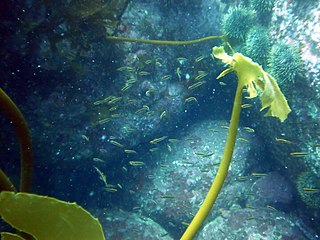
Threefin or triplefin blennies are blenniiforms, small percomorph marine fish of the family Tripterygiidae. Found in tropical and temperate waters of the Atlantic, Pacific and Indian Oceans, the family contains about 150 species in 30 genera. The family name derives from the Greek tripteros meaning "with three wings".

The yellow-and-black triplefin, Forsterygion flavonigrum, a triplefin of the genus Forsterygion, is found around the north of the North Island of New Zealand at depths of between 15 and 30 m, in reef areas of broken rock. Its length is between 4 and 7 cm.

The oblique-swimming triplefin is a triplefin, found along the north east coast of the North Island of New Zealand from depths of about 5 m to 50 m. They are the only triplefins not to spend most of their time resting on the bottom, instead swimming in loose schools of up to hundreds of individuals above rocky reefs. When swimming their head is higher than the tail, giving rise to their common name.

The cryptic triplefin, Cryptichthys jojettae, is a triplefin of the family Tripterygiidae, the only member of the genus Cryptichthys, found around the coast of New Zealand. It length is up to 6 cm. The specific name honours a former staff member at the National Museum of New Zealand, Jorjette Drost, who participated in collecting specimens with Hardy.

The tropical striped triplefin, also called the striped threefin or neon triplefin, is a species of triplefin blenny that is native to the central Indo-Pacific.

Springerichthys is a genus of triplefins in the family Tripterygiidae. The two species in this genus are found in the western Pacific Ocean.
The giant triplefin is a triplefin of the family Tripterygiidae, the only member of the genus Blennodon, found around the coast of New Zealand. It length is up to 15 cm, and it is the largest known triplefin species.
Enneapterygius clea, or Clea's triplefin, is a species of threefin blenny in the genus Enneapterygius, described by German ichthyologist Ronald Fricke in 1997. It is endemic to Queensland, Australia.
Enneapterygius flavoccipitis, the yellownape triplefin or northern bicoloured triplefin, in Australia, is a species of threefin blenny in the genus Enneapterygius.
The northern yellow-black triplefin, also known as the northern Australian yellow-black triplefin, is a species of triplefin blenny in the genus Enneapterygius. It was described by German Ichthyologist Ronald Fricke in 1994. It is a tropical blenny, endemic to northern Australia, in the western Pacific and southeastern Indian Oceans. It is a non-migratory species which dwells in shallow tidal pools on coralline rock and in seagrass, and has been recorded swimming at a depth range of 0–15 m (0–50 ft). Male northern yellow-black triplefins can reach a maximum length of 2.8 centimetres.
Enneapterygius miyakensis, known commonly as the Izu Islands triplefin, is a species of triplefin blenny in the genus Enneapterygius. It was described by the German ichthyologist Ronald Fricke in 1987. It is only known to occur in the Izu Islands off Japan.
Enneapterygius ventermaculus, the blotched triplefin or Pakistan triplefin, is a species of triplefin blenny in the genus Enneapterygius. It was described by Wouter Holleman in 1982.
Enneapterygius pallidoserialis, the pale white-spotted triplefin, is a species of triplefin blenny in the genus Enneapterygius. It was described by Ronald Fricke in 1997. This species occurs in the western Pacific Ocean where it has been recorded from Indonesia, Japan, Malaysia, the Federated States of Micronesia, Philippines, Solomon Islands; Taiwan, Vanuatu and Vietnam. It occurs along rocky shorelines to depths of 8 metres (26 ft).
Enneapterygius rhabdotus, the umpire triplefin or South Pacific striped triplefin, is a species of triplefin blenny in the genus Enneapterygius. It was described by Ronald Fricke in 1994. This species occurs in the western central Pacific Ocean the Izu Peninsula in Japan, Taiwan, Batanes and Palawan in the northern Philippines, the Gulf of Thailand, Palau, and most of Melanesia east to the Pitcairn Islands.
Enneapterygius rhothion, the New Caledonian blackhead surf triplefin or surf triplefin, is a species of triplefin blenny in the genus Enneapterygius. It was described by Ronald Fricke in 1997. This species occurs in New Caledonia and Vanuatu.
Enneapterygius signicauda, known commonly as the flagtail triplefin, is a species of triplefin blenny in the genus Enneapterygius. It was described by Ronald Fricke in 1997. This species occurs in the western Pacific Ocean and has been recorded from American Samoa, southern Tonga, and Vanuatu, as well as southern Japan.

Forsterygion gymnotum, known commonly as the Tasmanian robust triplefin, is a species of triplefin blenny in the genus Forsterygion. It is native to coastal New Zealand, but has also been Introduced to Tasmania, Australia. It was described by Eric Oswald Scott in 1977 from Tasmania. It is thought to have reached Tasmania from New Zealand through shipments of osyters.
The fourspot triplefin is a species of triplefin blenny in the genus Helcogramma.
The Kulbicki's triplefin is a species of triplefin blenny in the genus Springerichthys. It was described by Ronald Fricke and John E. Randall in 1994, honouring the fish ecologist reef-fish ecologist Michel L. Kulbicki of L'Office de la Recherche Scientifique et Technique d'Outre-Mer in Nouméa, who collected type in New Caledonia, in its specific name. Kulbicki's triplefin is found in the southwestern Pacific Ocean from Queensland, Australia across the central Pacific to the Samoa, where it is found on rocky and coral reefs down to 15 metres (49 ft) in depth.
Blacktail triplefin is a common name for several species of fish in the threefin blenny family (Tripterygiidae) and may refer to:








